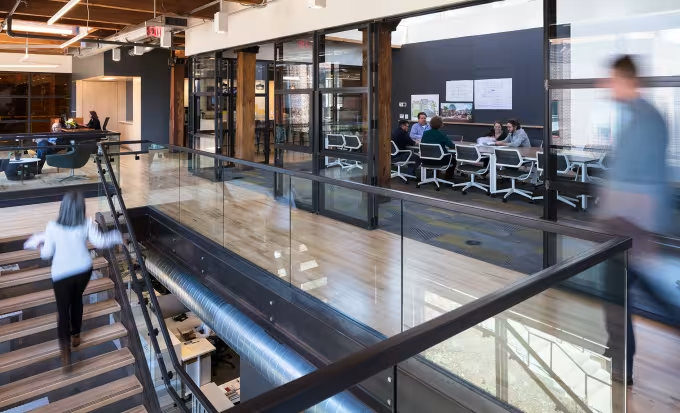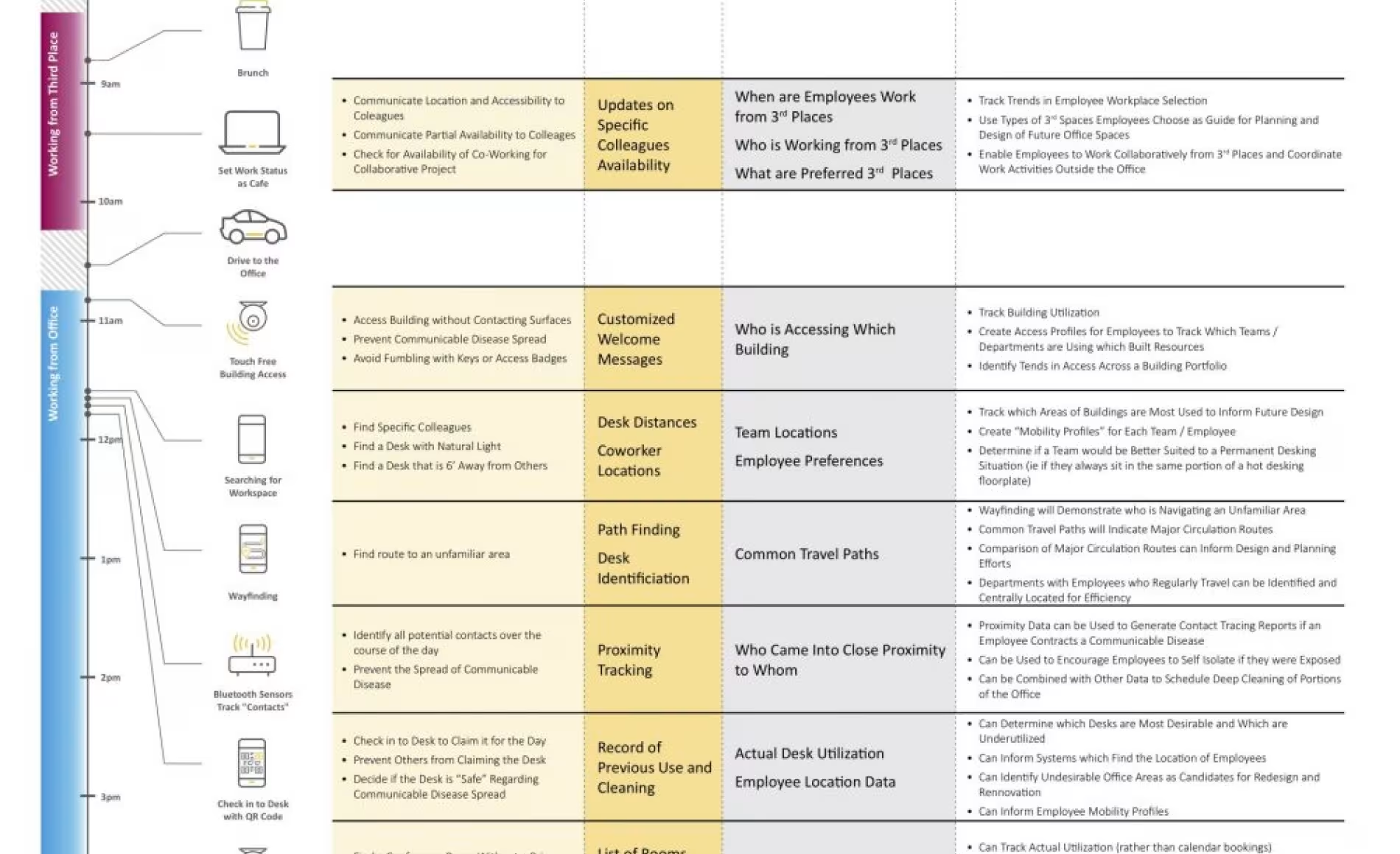Applying Software To The Workplace Experience Journey

A version of this article previously appeared in Work Design Magazine
The workplace of the future will not be a singular place, but rather a cumulative experience across a variety of venues based on a person’s daily activities. We’ve diagrammed a journey map of this experience, researched four families of technologies that support it, and identified three gaps in our survey of technology offerings that can be turned into opportunities for further technological development.
To get a complete story of the underlying technology necessary to support a digital-first approach, you must first understand work point data. A digital-first approach creates an integrated, omnichannel experience by breaking down inherent biases in the separation of in-office and remote work channels.
We’ve seen this migration from separation to integration play out in the evolution of the financial services industry. Until recently, most banking organizations had vertical divisions dedicated to two distinct customer experiences: one for an online experience or digital banking channel, and the other for an on-premises experience or branch bank channel. Today, these divisions are being blurred and dissolved into an integrated, omnichannel view of the customer experience. Similarly, in the car buying process, a trip to an auto dealership is increasingly the last step of the customer’s journey. That is, of course, unless the drive-ready automobile being purchased is simply delivered to their home! We anticipate that providers of workplaces and related service delivery will need to innovate their business models into a similarly integrated, omnichannel experience. This experience is digital-first and reimagines the purpose why workers choose to go into a physical office environment.
In thinking about the blurring of the digital and physical, the workplace experience journey can be mapped as a series of choices. We can anticipate activities, individuals’ goals, levels of decision support, and the collection and application of relevant data at various points in a typical day. In a “work anywhere” world, work takes place across one or more venues throughout the day, none of which should be considered “remote work” sites or treated as secondary locations. This network of venues includes the home, the office, and a variety of third places. Cuningham’s Work Studio, together with our research team, have developed a journey map to diagram the relationships between work and place, and to identify where the application of software can facilitate data collection about workforce utilization patterns of real assets and cloud services. These myriad point-solutions can be categorized into four families of technology:

1. Sensing Technologies
These are technologies that observe measurable characteristics of an environment or individuals. Examples include temperature sensors, Bluetooth tracking, cameras, infrared occupancy sensors, etc.

2. Real-Time Resource Management
These are technologies that provide intuitive and user- friendly means of reading and writing to a live database, tracking how certain asset types are used over different granularities of time. Examples include hot-desking applications, conference room booking tools, or facilities management software.

3. Analysis and Visualization
These technologies are often integrated into or built on top of the other three categories, as analysis and visualization allow people to understand the structure, organization and meaning of underlying data. Analysis finds trends and patterns in the data while visualization makes these legible to the people who must make data-informed decisions. Additionally, the results of analyses can feed into business automation to create more intelligent processes and systems. Examples of these technologies can be as simple as color-coded floor plans, or as complex as machine-learning models built from historical data.

4. Business Process Automation
These are technologies that can create changes in a business’s physical or digital environment based on input from other data sources. They can be built to respond to the output of the other three categories. An example of responding to sensing technologies would be to open automated blinds when the light levels are too low in a space. An example of responding to resource management technologies would be to generate an automated cleaning ticket when a desk is checked out. An example of responding to analysis would be to anticipate that on cold days a certain conference room requires a greater amount of heating relative to other spaces to remain comfortable (as can be inferred from historical analysis).

To view this graph in a larger format, CLICK HERE
Ideally, an enterprise wants to use these applications to improve the workplace experience journey from an end-to-end perspective. With this said, we see several challenges stemming from gaps in applications across the spectrum of activities in the journey. However, these challenges present further opportunities for technological development. These gaps include:
Technologies Related to Third Places
Most of the technologies managing the workplace experience outside of the office are focused on working from home. However, third places can have several unique characteristics. They can allow for in-person collaboration as well as solitary, “heads-down” work; they can be less ideal for video conferencing or phone calls; time spent at a third place can be either planned or spontaneous; they often have a higher social energy than either working from home or working in the office. These differences create the potential for new technologies regarding sharing or advertising one’s geo-location, planning for collaboration in third spaces, and opportunities for the third spaces themselves to offer new services and spaces that make their business more appealing as an alternative work environment.
Data Integration and Interoperability
Many of the technologies we surveyed keep data in proprietary formats and use their own custom apps and web interfaces to interact with the data they manage. While some products offer an accessible API to their platform, there is still significant overhead and cost to integrating and analyzing information from multiple APIs, particularly if the data from one source is not provided in a compatible format. There is opportunity for these platforms to standardize data formats, which would allow the development of third-party, user-friendly analytical tools to track data coming from disparate products and platforms in one centralized location.
Information on Quality of Workplace
The data being tracked by workplace experience products tends to be very functional and utilitarian, focusing on considerations such as availability of resources, location services, and activity tracking. There is a significant lack of quantitative information about the quality of spaces, including the acoustic, thermal, visual, and air quality. There is also a need to provide data on qualitative characteristics such as employee work style preference, the social attributes of spaces, and employee satisfaction with their environment.
Closing these gaps will add value for both the individual and the enterprise by improving the quality of workplace-as-a-service or reducing its provisioning costs. This may come in the form of new ideas for apps, open-source coding that disrupts proprietary product ecosystems, or business model innovations that integrate the digital and physical realms of the work experience.